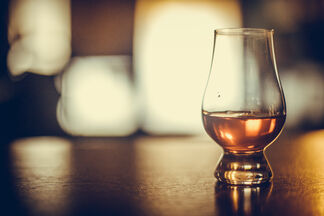
How to appreciate a whisky
Raising your curiosity
If you are following this blog, then I am reasonably sure that you have tried and tasted whisky. And some of you more than others! And there is absolutely nothing wrong with sitting down with a glass of whisky and simply drinking and enjoying it! But in this blog entry, I would like to help your enjoyment by pointing out a few things that might increase your appreciation of what you are drinking. And maybe increase your curiosity.
Before we get started, though, I want to tell you about a conversation I had in the whisky hut with a good friend of mine. We were comparing beer drinking with whisky drinking and we came to a conclusion that whisky drinkers are much more curious and experimental than beer drinkers. Controversial, I know! But beer drinkers tend towards brands they know and tastes they know they like. Places to go for a drink is often influenced by the brewery providing the beer. While whisky drinkers tend to go into a bar where the selection is the broadest. They will stare at the "top shelf" of bottles and usually choose one that they have not yet tried. Again, just a conversation and I know some of you will not agree - and that is OK! Share your view in the comments at the end!
So let's get on with it and talk about how you can go about appreciating a whisky ….
Pour it!
Just getting ready
Make sure you have a nice clean glass. If you are trying a second or a third whisky using the same glass, just make sure you have swilled out any remnants of the last whisky before pouring the next. For a tasting, rather than a casual drinking, try and use a tulip-shaped glass called a “Glencairn” glass. They are shaped to hold the aromas better than a straight sided glass. Whisky should be served at room temperature, between 18° and 22°C (64° and 72°F). 2Cl is enough when trying a few whiskies, but if this is the one you like do not hold back (but please be responsible!). At this stage, do not add any water – we will come to that later – and do not add ice. The first step is about appreciating the whisky as it came to you in the bottle.
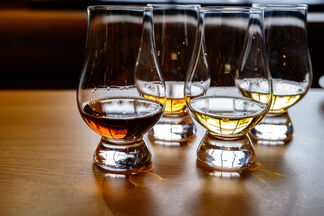
Look at it!
Drink first with your eyes
Now this may sound a bit strange, but the first thing you should do when "tasting" a whisky, is to look at it. Hold the glass up to the light and take a good look at the colour. Remember, the only influence on colour of the whisky is the cask. So the colour will give you a bit of a clue about the cask that the whisky has been matured in and what flavours are to come!
Take a look at the picture here. These are all whiskies from a single distillery. Made exactly the same way and aged for roughly the same number of years. But aged in different cask types. A port cask will give the whisky a very dark colour – sometimes almost black. A fresh oak cask will give the whisky a golden colour. A sherry, or a marsala cask will produce a dark brown whisky while a bourbon cask will give you a lighter brown colour. There are also whiskies from red wine, white wine and rum casks which will tilt the colour. But looking at the colour is a great way to start to anticipate what is to come.
Now swill the whisky around the glass and let it settle back down. Take a look at the legs (or tears) of a whisky, and the slowness with which they fall down the glass. Legs give you an idea of a whiskies alcohol content. The higher the alcohol content of the whisky, the more legs there will be and the slower they will form and fall. A good thing to know before you take a sip.
And yes, it is even better if you can line up two or three different whiskies side by side and really see the difference.
Smell it!
Check out the aromas to learn more about it
Next, and sorry again to delay tasting the whisky, is to smell it. Swill the whisky around the glass again to let the aromas lift out of the liquid. Sniff it using one nostril and then the other. Why that? Well our nostrils actually work in pairs – one nostril will be up to 80% open while the other is closed. And they swap over roles every 2 or 3 hours. So trying the aroma’s with both nostrils will help maximise your receptiveness and appreciation.
Aromas come from the production and the maturation processes of the whisky. Primary aromas come from the type of barley and its malting (such as smooth or peaty or smoky). Secondary aromas from fermentation and distillation, (such as yeasty, metallic and milky aromas). And finally tertiary aromas from maturation and the cask type. These could be vanilla, spicy, winey or woody aromas.
The aroma, or the "nose" will start to extract some of the other aspects of the whisky. You should be able to distinguish between a peaty, or smoky whisky and a smooth whisky. And the more you try this, you will start to be able to detect where a whisky comes from. Island whiskies will smell a tad salty or light peat. Whereas an Islay whisky will typically be rather peaty.
Recognizing familiar smells can be really interesting. Very often I hear “I know what that smells of but I just cannot place it!”. Your nose can be trained. When I give talks, I start with a little test where I use 10 different familiar aromas and ask the group to name them. Some are obvious, others not so. But if you are really interested, be aroma aware and train your nose with everyday fruits, spices and drinks like tea and coffee. You will be amazed how curious your nose becomes!
Also note that a whisky with high alcohol content will give the sensation of burning on the nose. Adding a drop or two of water at this stage can help smelling the whisky by removing the alcohol influence – which tends to mask the other aromas. Sipping and smelling can be repeated and the whisky diluted a little each time with water.
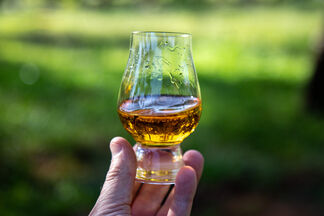
Sip it!
But beware the alcohol content!
Should have mentioned this earlier (sorry) but before tasting a whisky, you should also avoid consuming any food or drink with strong tastes that would be likely to alter it (for example coffee, liquorice, mint, etc.). But anyway, now you can sip your whisky. Swirl it around your tongue a bit and expose some of the first impressions. Try to keep it in your mouth for 20 to 30 seconds if possible! It will help your taste buds to settle and also to let your mouth look beyond the alcohol. It is also important to move the whisky from the front, to the centre and to the back of the tongue in order to try different areas and optimize the variety of tasting effects. Taste buds are distributed across the area of your tongue. Describing what you taste is entirely personal and it is fun to compare what you taste versus tasting notes which often accompany a whisky. Common notes are vanilla, caramel, soot, smoke, leather, red fruit, apples, sweetness.
As mentioned above, especially in whiskies with a relatively high alcohol content, try adding a few drops of water. Use a pipette if you have one. If not, try using a straw. And if not a straw, use a teaspoon. Each time you add water, you will remove the alcohol dominance and get to the core aromas and tastes. But don’t water it down too much!
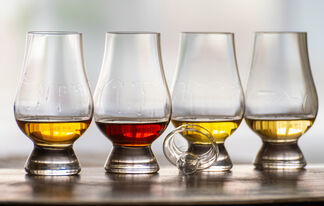
Try a Whisky Flight!
Experience the differences in whiskies
Comparing whiskies side by side is a really great way to explore the various regions, casks and production methods of individual distilleries. In my tastings and talks, I often put 4 or 5 whiskies from a single distillery together. Each of similar age. But matured in a variety of casks. This way, you can really check out the cask influence. Whisky Flights from distilleries in a single region are also a great way to compare production method influence over the final product. And of course, a walk through whiskies from each of the regions is a great way to experience Scotland. Contact me if you have an event or just want suggestions!
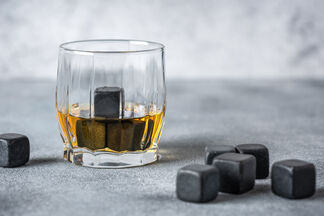
Frequently asked questions
Things you might want to ask about
Should I add water? Yes. Water helps remove the alcohol influences. If too strong in alcohol, the whisky core tastes and aromas will be lost. There is nothing manly about drinking whisky without a few drops of water, but don’t water it down too much. Add a drop at a time.
Should I add ice? No. Ice is frozen water which will melt in the glass. As it melts, the water content of the drink will increase and you will lose control over what you have added. If you want whisky cool, which is not a bad idea at all, use granite blocks that have been in the refrigerator.
Is it really bad if I add coke? You bought the whisky so you can do what you like with it. But given the time it takes to make a single malt whisky, and the price you pay for it, I find it a bit disrespectful to add coke, ginger ale, or anything else other than a drop of water. If you want coke or ginger ale with whisky, I recommend a blended whisky of which there are some really good ones.
What glass should I use? The easy answer is any you like as long as it doesn’t leak. But it honestly depends. If you are following the steps outlined above, I recommend a glass shape called “Glencairn”. It is a kind of tulip shape that holds the aromas better. But if you are sitting in a room with friends, or alone by an open fire, just enjoying a dram or two, a straight sided glass will suffice.
More questions? Just send me a comment to this blog entry, or send me something over the contact form.
Crazy Tips Corner:
Something you can do which sounds totally bizarre but can be effective
If the alcohol content of a whisky is extremely high (I have some in my collection in the high 60’s), the alcohol can really dominate the aroma. It can burn your nasal passages and make it all a bit unpleasant. So try this …. Put one or two drops of whisky in the palm of your hand. And rub your hands together. The alcohol will evaporate and you are left with the aroma. A bit like a perfume. This way, you really get to smell the whisky without the alcohol getting in the way. Don’t knock it until you have tried it.